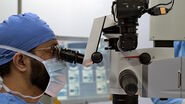About the case study
Key Learnings:
- Learn about the surgical management of a patient referred for angle closure with vitreous in the anterior chamber
- Discover the different steps of cataract surgery and intraocular lens implantation for a dislocated cataract
- Understand the role of intraoperative OCT in providing additional details in cataract surgery
Case Description
A 56-year-old male developed sudden pain in the right eye and vision loss. The patient had no prior trauma or surgery and he had 20/20 vision in the left eye. He was referred for angle closure with vitreous in the anterior chamber.
The intraocular pressure was extremely elevated at IOP 56mmHg, treated down to 23mmHg on four medication classes. The patient was hoping for a quick recovery to return to work.
The objective of the surgery was to manage the dislocated cataract to achieve a long-term good result without having a lens dislocation in the future.
Pre-operative assessment
For the pre-operative assessment, intraoperative OCT scans revealed a tuft of vitreous in the anterior chamber and a severely tilted lens. There was no sulcus space on one side and the other side was hyper deep behind the iris, where the vitreous was coming around. The lens was very mobile, and the angle would open when the patient would lay back.
Continue Reading
Read more and discover how Dr. Sheybani manages a dislocated cataract utilizing the Proveo 8 with built-in EnFocus Intraoperative OCT.
Disclaimer: Please note that off-label uses of products may be discussed. Consult with regulatory affairs for cleared indications for use in your region. The statements of the healthcare professionals included in this presentation reflect only their opinion and personal experience. They do not necessarily reflect the opinion of any institution with whom they are affiliated or Leica Microsystems.






